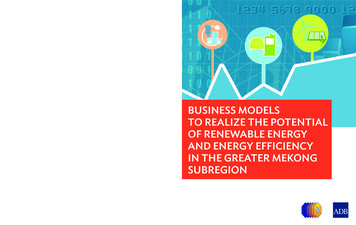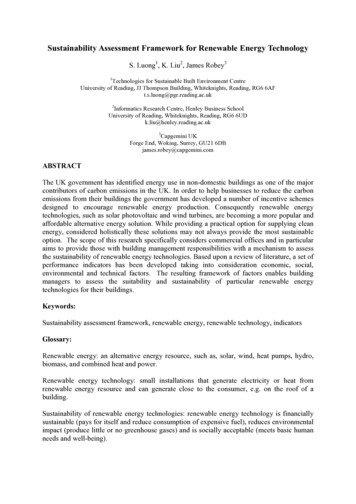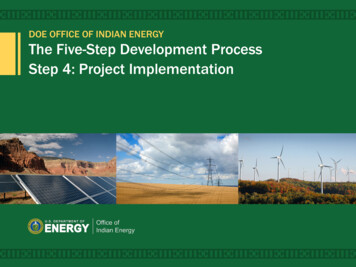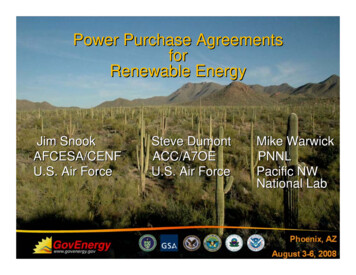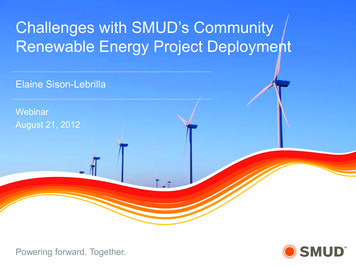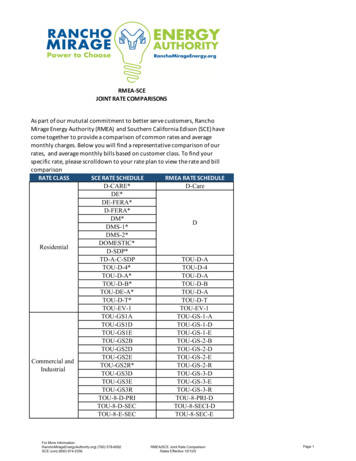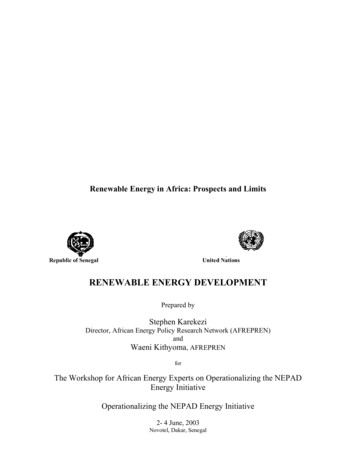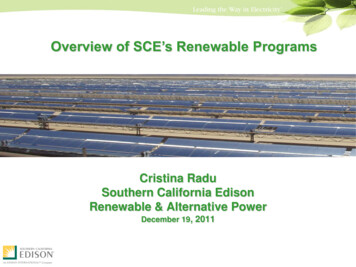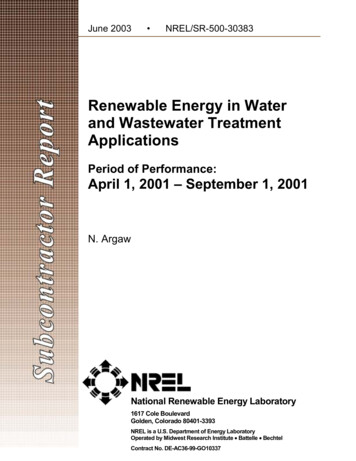
Transcription
June 2003 NREL/SR-500-30383Renewable Energy in Waterand Wastewater TreatmentApplicationsPeriod of Performance:April 1, 2001 – September 1, 2001N. ArgawNational Renewable Energy Laboratory1617 Cole BoulevardGolden, Colorado 80401-3393NREL is a U.S. Department of Energy LaboratoryOperated by Midwest Research Institute Battelle BechtelContract No. DE-AC36-99-GO10337
June 2003 NREL/SR-500-30383Renewable Energy in Waterand Wastewater TreatmentApplicationsPeriod of Performance:April 1, 2001 – September 1, 2001N. ArgawNREL Technical Monitor: L. FlowersPrepared under Subcontract No. AAM-1-31224-01National Renewable Energy Laboratory1617 Cole BoulevardGolden, Colorado 80401-3393NREL is a U.S. Department of Energy LaboratoryOperated by Midwest Research Institute Battelle BechtelContract No. DE-AC36-99-GO10337
NOTICEThis report was prepared as an account of work sponsored by an agency of the United Statesgovernment. Neither the United States government nor any agency thereof, nor any of their employees,makes any warranty, express or implied, or assumes any legal liability or responsibility for the accuracy,completeness, or usefulness of any information, apparatus, product, or process disclosed, or representsthat its use would not infringe privately owned rights. Reference herein to any specific commercialproduct, process, or service by trade name, trademark, manufacturer, or otherwise does not necessarilyconstitute or imply its endorsement, recommendation, or favoring by the United States government or anyagency thereof. The views and opinions of authors expressed herein do not necessarily state or reflectthose of the United States government or any agency thereof.Available electronically at http://www.osti.gov/bridgeAvailable for a processing fee to U.S. Department of Energyand its contractors, in paper, from:U.S. Department of EnergyOffice of Scientific and Technical InformationP.O. Box 62Oak Ridge, TN 37831-0062phone: 865.576.8401fax: 865.576.5728email: reports@adonis.osti.govAvailable for sale to the public, in paper, from:U.S. Department of CommerceNational Technical Information Service5285 Port Royal RoadSpringfield, VA 22161phone: 800.553.6847fax: 703.605.6900email: orders@ntis.fedworld.govonline ordering: http://www.ntis.gov/ordering.htmPrinted on paper containing at least 50% wastepaper, including 20% postconsumer waste
ForwardThe availability of clean drinking water is a development issue faced by billions of people in thedeveloping and near-developed world. Development organizations continually site the lack of access toclean water and sanitation as the leading cause of death amongst children in rural areas. The scale of thisproblem is immense, as are its solutions. The global nature of this issue opens the door for the applicationof communal solutions, as was demonstrated by the discussions surrounding the Johannesburg globalclimate meeting where water issues were a key concern that all nations could come together to support.Like energy, the need for clean water is increasing rapidly as supplies of traditional resources continue todiminish due to overuse, waste, and pollution. Unlike energy, the ability to harness local resources toproduce water is not possible. However, we do have the capability to use local energy resources to gainaccess to water supplies that would otherwise be unavailable and then ensure that this water is safe forhuman consumption. Most water is located underground in deep aquifers, in surface lakes, rivers, andstreams or in the ocean. Technologies exist to make use of all of these water sources but in many cases,the absence of available, inexpensive energy makes their use expensive, time consuming, and potentiallydangerous. The proper application of any number of energy options available today can make gainingaccess to this water a reality in many areas not previously considered.This report, one of three written by the author, provides insight into providing water to people in ruralareas. By considering all aspects of water systems from assessing availability, accessibility, treatment,supply systems, and post use treatment, this document provides insight into all aspects of the watersystem. The document also discusses a variety of energy sources available to rural and remote areas toprovide power for any proposed water systems. The report is unique as it provides a very evenhandedapproach to the selection of different technologies and power choices.The purpose of this document is to provide insight into the different options that are available andmethods to understand which technology may be the best for specific needs, conditions, and locations.We also hope to dispel some of the misconceptions about appropriate or inappropriate technologiesthrough the publication of this document. Because the access to clean water is such a large andencompassing issue, all solutions have their place. The difficulty is determining which technologies aremost appropriate for each user’s specific need.This book is one in a series of guidebooks that NREL produced, with the support of the U.S. Departmentof Energy, to couple commercial renewable energy systems with rural applications, including other waterissues, rural schools, health posts, and micro-enterprise. Other water related publications in this seriesdescribe the technical aspects of water pumping technology and provide insight to issues of watertreatment, specifically purification, desalination, and wastewater treatment.E. Ian Baring-GouldInternational ProgramsNational Renewable Energy Laboratoryiii
Table of ContentsChapter 1: Introduction .1Background .1Purpose of This Book.1Chapter 2: Water Resources and Water Quality .3Water Resources .3Raw Water Quality .5Water Storage.6Chapter 3: Energy Sources for Water-Supply Technologies .8Diesel, Gasoline, and Kerosene Pumps .8Diesel Engines .9Gasoline/Kerosene Engines .10Grid-Connected Electric Pumps .10Wind Pumps.11Mechanical Wind Pumps (Windmills).11Electrical Wind Pumps .12Solar (Photovoltaic) Pumps .13Bio-fuel Pumps .14Chapter 4: Rural Water Supply Technologies .16Open Wells and Hand Pumps .17Gravity-Flow Water Supply Systems .17Motorized Water Supply Systems .18Other Water Supply Systems .19Water Treatment in Rural Areas of Developing Countries .20Chapter 5: Water Purification Technologies.22Traditional Water Treatment Methods.22Traditional Groundwater Treatment .22Household filtration .22Slow Sand Filtration .23Conventional Surface Water Treatment.24Other Water Treatment Options.26Desalination .26Reverse Osmosis .27Electrodialysis .29iv
Water Disinfection Options .29Most Common Disinfectants in Use for Conventional Water Treatment Plants .29Ultraviolet Light .31Pasteurization.31Silver Disinfection .32Iodination .32Other Water Disinfection Options .32Mixed-Oxidant Gases Generated on Demand .32Photocatalysis .33Other Issues Related to Water Purification.34Incoming Water Temperature .34pH Scale .34Hardness.35Toxicity of Coagulant Residuals.36Health Risks Associated with Disinfection.36Improving Water Quality by Combining Purifiers .37Chapter 6: Wastewater Sources and Treatment .38Rural Sanitation .39Municipal Wastewater Treatment.40Stabilization Ponds.41Anaerobic Ponds.42Facultative Ponds.43Maturation Ponds.43Aerobic Stabilization Ponds.44Aerated Lagoons/Oxidation Ditches.44Other Emerging Technologies in Wastewater Treatment.44Solar Detoxification.45Chapter 7: Appropriate Technology Assessment .47Water Resources Assessment .48Water Supply Technologies Assessment .48Rural Water Supply.48Urban Water Supply .50Emerging Technologies .52v
Wastewater Treatment Technologies Assessment.52Renewable Energy Resources in Water and Wastewater Treatment.53Bibliography .55Glossary .58vi
FiguresFigure 2.1. The hydrological cycle of water .3Figure 2.2. A water storage system for cattle .6Figure 2.3. Schematic diagram of a typical village water supply.7Figure 3.1. Diesel generator at a rural Panamanian hospital .9Figure 3.2. A schematic diagram of a windmill with a piston pump.11Figure 3.3. Schematic diagram of an electrical wind turbine connected toa submersible centrifugal pump .13Figure 3.4. A typical village water supply using a PV pump located in Ethiopia .14Figure 3.5. A trailer-mounted 3-kWe prototype SMB with its development team .15Figure 4.1. Traditional open well used to fetch water using a bucket and a pulley.17Figure 4.2. An Indian Mark II-type hand pump used in rural villages .17Figure 4.3. Gravity-flow village water supply system.18Figure 4.4. Two types of surface pumps: a) centrifugal surface pump and b) jack pump.19Figure 4.5. Schematic diagram of rooftop rainwater catchment.19Figure 5.1. Construction of a household sand filtration system .22Figure 5.2. Schematic diagram of a typical slow sand filtration system .23Figure 5.3. Schematic diagram of a typical conventional water treatment plant.25Figure 5.4. A simplified schematic diagram of a solar still .26Figure 5.5. Various reverse osmosis systems for both home use and large water supplies.28Figure 5.6. A 60-watt 15 l/min (4 gal/min) UV water disinfection unit developed at theLawrence Berkeley National Laboratory, U.S DOE .31Figure 5.7. Schematic diagram of the mixed-oxidant gases generated on demand process .32Figure 5.8. A schematic diagram of a solar water detoxification system .34Figure 6.1. Schematic diagram of a ventilated improved pit (VIP) latrine developedin Zimbabwe .39Figure 6.2. Schematic diagram of a pour-flush latrine construction.40Figure 6.3. Schematic diagram of the three stages of a wastewater stabilization pondwith aerated lagoons .42Figure 7.1. Typical chlorinators used for disinfecting a rural water supply .50Figure 7.2. A typical horizontal-flow settling tank and an upward-flow clarifier.51vii
TablesTable 4.1. Typical Daily Water Consumption for Farm Animals .16Table 4.2. Estimated Maximum Daily Water Demand for Various Types ofCrop Irrigation .16Table 5.1. Some of the Possible Combinations of Purifiers for Home-Use Application(Ingram 1991).37viii
Chapter 1: IntroductionBackgroundAbsolutely pure water is not found in nature. Water evaporates into the atmosphere, condenses,and when it falls back to the ground, the water contains dissolved gases including oxygen,carbon dioxide, bacteria, and dust absorbed from the air. Once the water hits the ground, it picksup many more organic and non-organic chemicals, microorganisms, and organisms as it make itsway into streams and rivers. Some of the rainfall percolates into the soil, loosening suspendedsilt and bacteria. There is also the danger of contamination by radioactive isotopes in thegroundwater. Contaminants from the ground’s surface include municipal, industrial, andagricultural wastes. These wastes wash into rivers and also infiltrate the groundwater. Dependingon the intended use, all of these contaminants need some kind of treatment.Generally, wastewater requires a certain level of treatment before it can come into contact withthe surface or with groundwater. Similarly, domestic water should be clean and safe to drink.Depending on the source, domestic water requires some kind of treatment.Renewable energy sources have been used and will continue to be used, either directly orindirectly, in water and wastewater treatment. Solar energy—typically stabilization ponds andsolar detoxification—is often used for wastewater treatment and is still used in many countries.Solar energy is still the simplest technology for desalination of salty waters, and for waterdisinfection. Solar still is the simplest desalination technology. It can be converted intoelectricity, which can be used to power pumps, ultraviolet (UV) systems, photocatalysis, reverseosmosis (RO), and conventional surface-water treatment systems.Similarly, wind energy has been used since 1200 BC by the Persians. In the early 1900s, theAmerican Farm windmills supplied water for both the railroads and for domestic uses. Windmillscontinue to be very popular for pumping water. Today, there are more than one millionwindmills in the United States, Argentina, and Australia alone. Like solar photovoltaic (PV)systems, wind turbines convert wind energy directly into electricity, and the electricity producedcan be used to power water treatment systems. However, wind machines are normally not usedfor wastewater treatment since most wastewater treatment systems have very large powerrequirements or require direct sunlight (e.g., stabilization ponds).Today, however, renewable energy sources, unlike conventional power sources (petroleum-basedgensets and power from the grid), are mostly used for small to medium applications because oftheir high initial investment costs. The power needed to treat a rural water supply is relativelysmall and for this reason renewable energy power sources are widely used in many developingcountries.Purpose of This BookThis guidebook is to help readers understand where and how renewable energy technologies canbe used for water and wastewater treatment applications. It is specifically designed for rural andsmall urban center water supply and wastewater treatment applications. This guidebook also1
provides basic information for selecting water resources and for various kinds of commerciallyavailable water supply and wastewater treatment technologies and power sources currently in themarket.Chapter 2 discusses water resources, raw water quality, and water storage. Chapters 3 and 4present the available energy resources for water-supply applications and the kinds of rural watersupply technologies. Chapters 5 and 6 provide basic information about water purificationtechnologies and wastewater sources and treatment. Chapter 7 discusses appropriate technologyassessment, and Chapter 8 presents the bibliography.2
Chapter 2: Water Resources and Water QualityWater is a fundamental part of life, and for years everyone took it for granted. Recently,governments and concerned individuals worried that water resources were finite and could belost to contamination or sudden loss, or from the pressure of large-farm irrigation that wouldcreate physical and chemical stresses. The decline of the underground water table (e.g., inPhoenix, Arizona) and an increase in the salinity of the water through excessive use of water forirrigation (e.g., the Colorado River) are prime causes for concern about water resources and theirquality.Water ResourcesApart from its day-to-day use for drinking, irrigation, and marine life, water is used for manyapplications. It is used as a solvent (water dissolves more substances in greater quantities thanany other liquid), for heating spaces (except for liquid ammonia, water has the highest heattransfer capacity, and is better suited for heating buildings), and for its ability to conductelectricity through dissociation, when acid is added (e.g., in automobile batteries). Therefore, it isnecessary to understand the existence ofwater. For example, the presence ofunderground water depends not only on theRainCloudscloudscreation of the storage facilities (betweenrocks, clays, and permeable soils) but also onnature’s ability to keep them supplied. We allknow that there can be an abundance of waterSolarPrecipitationRadiationin one area or scarcity in other. To understandEvaporationwhy water is present, we need to know thereasons for the uneven distribution ofprecipitation over the earth’s surface and theprocesses involved in the movement of waterInfiltrationfrom place to place. In principle, the totalOceanvolume of water on this planet is finite andFigure 2.1. The hydrological cycle of water: water from constant, but the uneven distribution of waterthe sea evaporates to form clouds; falls back to earth on the earth’s surface is due to hydrologicalas precipitation; and via streams, rivers, andcycle and weather patterns. The hydrologicalinfiltration, returns to the sea.cycle of water can be easily visualized fromFigure 2.1.In principle, it is solar energy that causes the uneven distribution of water on the earth’s surface.The water itself serves as a thermal energy storage medium, which determines the threeparameters of climate: air temperature, air pressure, and precipitation. When solar radiationstrikes the earth’s surface, the earth is heated. At the Equator, there is a net heat gain, while at thepoles, there is a net heat loss. Through the movement of the oceans and the atmosphere, thesurplus heat moves toward the poles. The cool air is heated when it reaches the earth’s surfaceand rises back into the atmosphere, while the warm rising air that contains water throughevaporation eventually cools and falls back to earth as rain. Water from the sea evaporates toform clouds, returns to the earth as precipitation, and via streams, rivers, and infiltration, returns3
to the sea. This process is called the hydrologic cycle. This cycle creates certain weather patternsso that one location is dry while another location is wet. Therefore, the sources of water varyfrom one locality to another. However, the availability of groundwater depends not only on thehydrologic cycle and weather pattern. It also depends upon the formation of aquifer systems. Theformation of aquifers can be from weathering, erosion, glacial deposits, sedimentary rocks,alluvial aquifers, and/or igneous and metamorphic rock aquifers.There are two main water sources: surface water and groundwater. Surface water sources arerivers, streams, man-made ponds or reservoirs, lakes, and seas. Streams are generally seasonal;depending on the size and tributaries, river-water sources can be seasonal or year round.Seasonal water sources require man-made dams or reservoirs for water supply and irrigationpurposes. However, water resources from year-round rivers or lakes do not require such storage.Generally, surface waters require treatment for domestic water supply, and this will be discussedin the following chapters.Groundwater resources are formed when the surface is over-saturated and the excess water filtersdown. The depth of the soil water zone varies from about 1 meter (m) to 9 m (3 feet (ft) to 30 ft).Water is also lost by transpiration and evaporation. Soil undergoes wide variations in moisturecontent—from complete saturation to a total lack of moisture. Water is held in the soil bymolecular or capillary attraction, acting against the force of gravity. Molecular attraction holdswater in a thin film on the surface of each soil particle. Capillary attraction holds water in thesmallest spaces between soil particles. Water begins to percolate downward under the force ofgravity when the water-holding capacity of the capillary forces is exceeded. The regionimmediately below the soil water zone is called the intermediate zone. Most water in this zonewill move downward, has no in-situ use, and cannot be recovered. There is a capillary fringe atthe bottom of the intermediate zone where groundwater is drawn upward by capillary forces.Depending on the kind of aquifer, water may migrate upward more than 3 m (Driscoll 1986).Well-sorted, fine sediments are most effective at holding water and are often completelysaturated within the capillary fringe zone; coarse sediments are not as effective in holding water.The groundwater table lies at the very bottom of the capillary zone. Generally, subsurface waterused for domestic purposes and irrigation is pumped from below the groundwater table.However, groundwater can also be springs or artesian wells, where water is forced from theaquifer by compaction caused by the weight of overlying sediments or a well that derives itswater from a confined aquifer in which the water level is above the ground surface. In suchcases, groundwater is capped at the surface (at the eye of the spring or artesian well).Groundwater found in shallow wells can generally be extracted using hand pumps or with asimple pulley and bucket. Such wells can be dug by hand or bored using earth augers. There arethree main types of earth augers: large-diameter bucket augers, solid-stem augers, and hollowstem augers. Large-diameter bucket augers are most commonly used to drill up to about 45 m(150-ft) deep and up to 1.2 m (48–inch [in]) diameter wells. Solid-stem augers can drill up to 35m (120 ft) deep and up to 600 millimeters (mm) (24 in) in diameter. The most common depth forhollow-stem augers in stable formations are 35 m (120 ft) for a 150 mm (6 in) diameter hollowstem auger and about 12 m deep for a 300 mm (12-in) diameter hollow-stem auger (Driscoll1986). Generally, deep wells are drilled using drilling machines. There are several types ofdrilling methods, depending on the geologic formation and the depth and diameter of the well.4
Particular drilling methods become dominant in certain areas because they are most effective inpenetrating the local aquifers and thus offer cost advantages. Some of the most common drillingmachines are cable tool drills, direct- and reverse-circulation rotary drills, and air drills. Rotarydrilling machines are mostly used to reach greater depths and to increase drilling speeds.Normally drilling fluids (air, clean water, and mixtures of special-purpose materials) are essentialfor efficient rotary drilling. However, direct rotary drilling is very expensive because drill bitsare costly and drilling rigs require a high level of maintenance. Reverse circulation drilling isgenerally most successful in soft sedimentary rocks and unconsolidated sand and gravel wherethe static water level is 3 m (10 ft) or more below ground level. This drilling method is the leastexpensive for drilling large-diameter holes in unconsolidated formations.Springs are commonly found at the foot of mountains. Mountains are also sources of streams,and many streams flow into rivers. Some rivers flow into larger rivers, such as the Amazon orthe Nile. When streams and rivers flow over a flat area, the surrounding area will generally havegood underground water because water soaks into the aquifer. Such areas are generally good forshallow wells. Although surface and rainwater infiltration are the main s
The scale of this problem is immense, as are its solutions. The global nature of this issue opens the door for the application . approach to the selection of different technologies and power choices. . up many more organic and non-organic chemicals, microorganisms, and organisms as it make its way into streams and rivers. Some of the .

